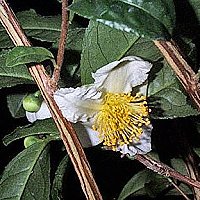
Camellia sinensis

Camellia sinensis
Origin - Asia
Part of the plant used - Leaf
Edible Parts Green tea is natural dried leaves of the tea plant, Camellia sinensis. Black tea is oxidized green tea. Both have been used for thousands of years in Asia, as beverage and medicine. Green tea extract is a bioflavonoid-rich, potent extract which is used primarily for fighting free radicals. It has a high content of polyphenols, which are a class of bioflavonoids.
Pharmacology - The polyphenols in green tea are catechins, with multiple linked ring-like structures. Polyphenols are a form of bioflavonoids with several phenol groups. They control both taste and biological action. The dominant and most important catechin in green tea is (-)epigallocatechin gallate (EGCG), a potent antioxidant which is used for food production, as well as in animal research studies. The phenol groups capture pro-oxidants and free radicals. EGCG is over 200 times more powerful than vitamin E in neutralizing the pro-oxidants and free radicals that attack lipids in the brain, in vivo. It is 20 times more potent than vitamin E in reducing formation of peroxides in lard by the Active Oxygen Method, in vitro.
Active Properties - Green tea extract is used primarily for its free-radical-fighting capabilities, but has a wide range of applications. Its key ingredient, (-)epigallocatechin gallate (EGCG), protects against digestive and respiratory infections. (A solution of 1mcg per ml of EGCG heavily inhibited influenza virus in vitro.) It helps block the cancer-promoting actions of carcinogens, ultraviolet light, and metastasis from an Origin:al site in the skin, stomach, small intestine, liver or lung. Higher quantities (0.5 percent to 1 percent of diet) were protective against high total and LDL-cholesterol promoting diet in rats. Crude catechins at 0.5 percent of diet were effective in lowering blood pressures in spontaneously hypertensive rats. (Both EGCG and black tea catechins suppressed angiotensin I converting enzyme, which causes essential hypertension.) EGCG also reduces platelet aggregation about as much as aspirin or Ginkgo biloba extract. Green tea is very effective in inhibiting pathogenic bacteria that cause food poisoning, but increases levels of acidophilous (friendly) bacteria. 500mg catechin ("e250 mg EGCG) daily regularized bowel habits significantly. Green tea also blocks the attachment of the bacteria associated with dental caries to the teeth.
Toxicity, Cautions & Contra-indications - Green tea extract is non-toxic both in acute dosage and high long-term dosage (no significant effect on weight gain at two percent of the diet in three months in rats). It has no potential for causing mutations or birth defects, and has no adverse effect on fertility, pregnancy or nursing.
Historical Uses: